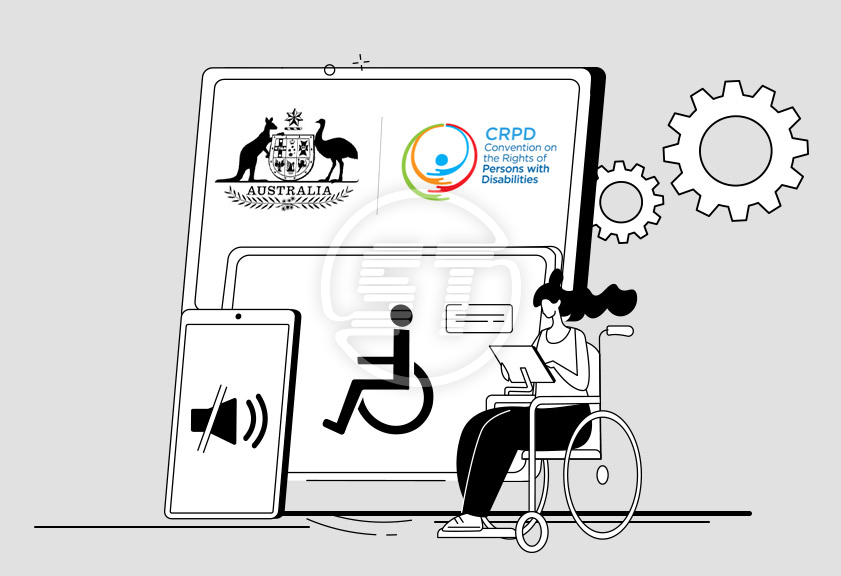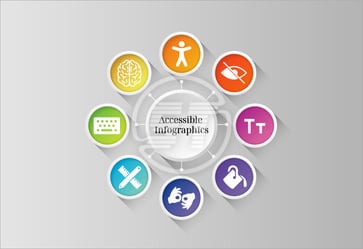What is accessibility means to you? Have you ever thought of an inclusive web environment, where nobody has been left behind due to the lack of some important information? Do you think such inclusive web environment can be created?
Yes, our joint efforts can help us with an accessible and usable web environment!
There are plenty of people who cannot peruse every random content online due to some or other physical disability. More than 4.4 million people in Australia fall in this category. Visual impairment, hearing disabilities, neurodivergence, and other temporary and permanent issues, are the reasons why some people need extra help or assistance to explore the web.
The Australian government has made the laws stricter than ever to ensure that everyone has full access to each piece of information on the web. The inaccessibility spectrum is broad and so is the number of inaccessible websites. There are some very common and major issues that make a website inaccessible. For example, mobile inaccessibility, keyboard navigation problems, inaccessible PDFs, inappropriate color contrast, etc.
If given proper attention to these basic yet critical details, not only website’s accessibility will increase, but website UX will improve as well.
Let’s learn about Australian web accessibility standards and make our websites usable and accessible.
Disability Discrimination Act (DDA) 1992
The Disability Discrimination Act is the Australian web accessibility standard guide that looks for equal web access for people with disabilities. This law is applicable to each organization and individual website or other web resources running in Australia or maintaining a web resource on an Australian server.
DDA is applicable on websites and other digital assets that are developed and/or maintained for the purpose of employment, education, services such as baking, financial services, entertainment, telecommunication, transport, government services, real estate, sport, NGOs, Commonwealth programs, etc.
Section 5 of DDA law says that inaccessible web content discriminates against disabled people by depriving them from information available on the web, whereas people without disabilities can access the same information. Moreover, the websites are supposed to make content adjustments in existing websites by performing reasonable changes to make the websites inclusive and accessible.
United Nations Convention on the Rights of Persons with Disabilities (UNCRPD)
Australian web accessibility standards get ratified by the United Nations’ convention on the rights of persons with disabilities in 2008.
Article 21 of this treaty says that States Parties should ensure that every person can have equal rights to freedom of expression and opinion. It includes exploring and receiving information and ideas through every channel of their choice on an equal basis.
Organizations ought to provide information in accessible formats to everyone irrespective of their physical disability type and without any additional cost.
Modes and formats of communication for disabled persons must be chosen by them. It can be the use of sign languages, Braille, an augmentative and alternative medium for communications, etc.
Treaty urges the private entities that offer public services using the internet, should provide usable and accessible information to people with disabilities.
Mass media services ought to be accessible to people with disabilities.
The treaty also encourages the recognition and promotion of sign languages.
This ratification of the UNCRPD implies that Australia is obligated to practice all the policies suggested by the Convention. The commitment pronounced, “the right of people with disabilities to participate fully and independently in all aspects of society, including the internet and access to information.”
National Transition Strategy (NTS)
A major part of the Australian web accessibility is supported by National Transition Strategy (NTS). In 2009, the Secretaries’ ICT Governance Board confirmed that the Australian government’s web resources will adhere to ADA compliance and WCAG 2.0 standards, mainly level AA. It meant every government website to implement WCAG 2.0 conformance within a span of four years that is maximum by 2014. And even after more than a decade time, many websites are still struggling to conform to the guidelines.
Complying with DDA – an obligatory practice!
Websites ought to have a design and layout that can be used by maximum people irrespective of their physical state. Making your website accessible requires only a bit of careful execution of suggested DDA guidelines. It is neither time-consuming nor costly, but if you won’t comply with the guidelines, lawsuits will be costlier.
The websites must follow the four basic concepts of the DDA or WCAG 2.0 (level AA) standard.
Perceivable: The website must accommodate different sensory issues like vision, sound, and touch, thereby, users can consume the content. Some of the basic practices to achieve perceivability are:
- Provide alt text with non-text content.
- Add a caption with video and multimedia.
- Focus on color contrast, etc.
Operable: The user interface and navigation of the website should be completely usable. To make the website operable, focus to
- Ensure smooth keyboard navigation.
- Provide enough time to read and use the content.
- Make logical navigation throughout the pages of the website.
- Avoid content that causes seizures, etc.
Understandable: Website information and navigation must be easy, consistent, and thoroughly comprehensive for everyone. To create understandable content, The text must be legible.
Offer assistance for users to correct their mistakes while perusing the website, etc.
Robust: The website should be adhering to all the standards and be compatible with every assistive technology.
Additionally, attached downloadable documents (PDFs) must be accessible and websites should be optimized for mobiles due to the increasing number of mobile users. Mobile incompatibility is one of the significant reasons for inaccessible web resources.
WCAG 2.0 has appropriate suggestions to create an accessible website. It covers a wide range of website issues. Though the Disability Discrimination Act focuses on level AA, organizations can go for the higher level (AAA) as well, if they wish to offer enhanced user experience. Well, find out the difference between WCAG compliance level A, AA, and AAA.
Are you ready to remove the accessibility barriers?
Accessibility allows you to tap into everyone’s potential. The more people will access your website, the more profits you’ll reap. Eventually, it is for the good of everybody.
Australia has shown good signs in establishing accessibility across the industries. There is a very popular example of Bruce Lindsey Maguire and the Sydney Organizing Committee for the Olympic Games case. That shows no website can take the laws casually.
Following these practices seem to be tough but once you have a habit of complying with suggested standards, you will find it much easier. If confused and not willing to learn the DDA or WCAG 2.0 standards, an experienced professional will be a great help.
Is your website compliant with the Australian Disability Discrimination Act (DDA)? Our team of experts provide web design services which are compliance with Australian DDA accessibility regulations. Our developers adhere to the highest standards set by W3C for XHTML, HTML 5, CSS, WCAG 2.0, WCAG 2.1, WCAG 2.2 and the Section 508 standards. We also stay on top of the latest accessibility standards and quickly get ourselves updated to assist you better and make your websites accessible for more people.


